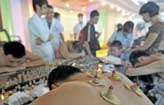Tips and Articles
Happy place
Updated: 2011-06-17 11:18
By Liu Xiaozhuo (China Daily European Weekly)
 |
1. Mount Gu
Mount Gu is 17 km east from downtown and boasts excellent views over the city. Mount Gu means drum hill in Chinese and gets its name from a large rock on the top of the mountain, which is shaped like a drum.
During thunderstorms, the heavy splashing of rain hitting the stone sounds like drum beats.
The ancients used to ponder if a mighty god from heaven was knocking on the drum to announce his arrival to the human world.
Mount Gu is green throughout all the four seasons and therefore a popular place of relaxation.
As a Buddhist scenic spot, there are many temples, the most famous being the Yongquan Temple or Spring Temple. The magnificent layout of the buildings that make up the Spring Temple captures the essence of Chinese traditional architecture.
2. Mawei
Mawei is 20 km from Fuzhou and is a town meaning "horsetail". Located on the north bank of Minjiang River, it is a typical water town.
It is well known as the cradle of China's modern industry and the birthplace of the nation's modern navy.
Mawei was a battlefield in late Qing Dynasty and is full of historic sites.
Visitors can see scenes of the past along the Minjiang River and with the sound of the steamships whistling by, can imagine what it was like during the chaos of the late Qing Dynasty.
Visitors can also look around Mawei Shipyard, the biggest ship-making base of Fujian province.
3. Earth towers of Hakkas
Hakka earth towers are a unique architectural feature of Fujian province and there are many located around Fuzhou city.
The earth towers were massive castle-like houses shaped like mushrooms. Some are more than 1,000 years old.
Their origin dates back to the Song Dynasty (960-1279) when Hakka people built them to protect themselves from wild beasts and bandits.
The smaller earth towers usually had two or three stories with 21 to 28 rooms. The bigger structures were usually three to four stories tall and contained 30 to 40 rooms.
Usually a whole clan lived together in one of the buildings and involved hundreds of people.
4. Sanfang Qixiang
Sanfang Qixiang is located in downtown Fuzhou and is lined with a cluster of old buildings that sparkle with ancient charm.
Sanfang Qixiang contains 10 lanes and alleys, among which three (san) in the west are called fang and seven (qi) in the east called xiang.
Sanfang Qixiang has 159 ancient buildings and the layout of lanes is unchanged since the Tang and Song dynasties.
Visitors can walk on these old streets, step back in time and feel what life must have been like in ancient times.
The lanes and alleys of Sanfang Qixiang, though intricately arranged, have a clear layout and feature many historical relics.
5. Minjiang Park
Minjiang Park is the largest open space in Fuzhou and combines the natural beauty of the parklands with the scenery of the Minjiang River.
Visitors can take a leisurely walk around the gardens or rent a bicycle to explore this popular park. Because it rests on the banks of the Minjiang River, it is a wonderful place to relax on the waterway.
There is a collection of 64 sculptures from talented artists of 14 different countries and regions.

Specials

Turning up the heat
Traditional Chinese medicine using moxa, or mugwort herb, is once again becoming fashionable

Ciao, Yao
Yao Ming announced his retirement from basketball, staging an emotional end to a glorious career.

Financial sector short of talent
Lack of skilled professionals in Shanghai inhibiting the city's development as a financial hub